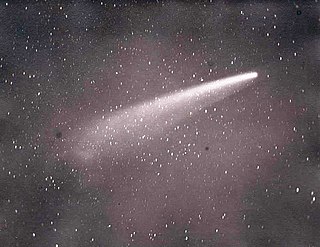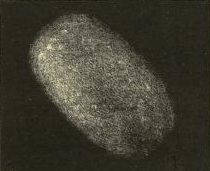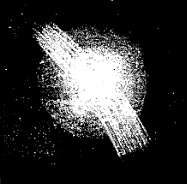
Comet Ikeya–Seki, formally designated C/1965 S1, 1965 VIII, and 1965f, was a long-period comet discovered independently by Kaoru Ikeya and Tsutomu Seki. First observed as a faint telescopic object on 18 September 1965, the first calculations of its orbit suggested that on October 21, it would pass just 450,000 km (280,000 mi) above the Sun's surface, and would probably become extremely bright.

The Great Comet of 1882, formally designated as C/1882 R1, 1882 II, and 1882b, was a comet which became very bright in September 1882. It was a member of the Kreutz Sungrazers, a family of comets which pass within 1 R☉ of the Sun's photosphere at perihelion.

5D/Brorsen was a periodic Jupiter-family comet discovered on February 26, 1846, by Danish astronomer Theodor Brorsen. The comet was last seen in 1879 and is now considered lost.
The Comet of 1729, also known as C/1729 P1 or Comet Sarabat, was an assumed parabolic comet with an absolute magnitude of −3, possibly the brightest ever observed for a comet; it is therefore considered to be potentially the largest comet ever seen. With an assumed eccentricity of 1, it is unknown if this comet will return in a hundred thousand years or be ejected from the Solar System.

Comet NEAT, formally designated as C/2002 V1, is a non-periodic comet that appeared in November 2002. The comet peaked with an apparent magnitude of approximately –0.5, making it the eighth-brightest comet seen since 1935. It was seen by SOHO in February 2003. At perihelion the comet was only 0.0992 AU (14.84 million km) from the Sun, where it was initially expected to be disintegrated, however reanalysis of its orbit has indicated that it has survived many of its previous perihelia, thus making breakup unlikely.

Comet Lulin, formal designation C/2007 N3, Traditional Chinese:鹿林彗星) is a non-periodic comet. It was discovered by Ye Quanzhi and Lin Chi-Sheng from Lulin Observatory. It peaked in brightness at magnitude between +4.5 and +5, becoming visible to the naked eye, and arrived at perigee for observers on Earth on February 24, 2009, and at 0.411 AU from Earth.

C/1989 X1 (Austin) was a comet discovered by New Zealand amateur Rodney R. D. Austin on December 6, 1989. The comet at discovery was predicted to become easily visible by naked eye in spring 1990, however it failed to become that bright.

The Great Comet of 1556 was a comet that first appeared in February 1556, and which was observed throughout much of Europe. The comet appears to have been seen in some places before the end of February, but it was not generally observed until the middle of the first week in March. Its apparent diameter was equal to half that of the Moon, and the tail was said to resemble "the flame of a torch agitated by the wind." Cornelius Gemma said that the head of the comet, when it first appeared, was as large as Jupiter, and that its color resembled that of Mars.

The Great Comet of 1823, also designated C/1823 Y1 or Comet De Bréauté-Pons, was a bright comet visible from December 1823 to April 1824.

The Great Comet of 1901, sometimes known as Comet Viscara, formally designated C/1901 G1, was a comet which became bright in the spring of 1901. Visible exclusively from the southern hemisphere, it was discovered on the morning of April 12, 1901 as a naked-eye object of second magnitude with a short tail. On the day of perihelion passage, the comet's head was reported as deep yellowish in color, trailing a 10-degree tail. It was last seen by the naked eye on May 23.

Comet Lovejoy, formally designated C/2011 W3 (Lovejoy), is a long-period comet and Kreutz sungrazer. It was discovered in November 2011 by Australian amateur astronomer Terry Lovejoy. The comet's perihelion took it through the Sun's corona on 16 December 2011, after which it emerged intact, though greatly impacted by the event.

C/1874 H1 (Coggia) is a non-periodic comet, which in the summer of 1874 could be seen by the naked eye. On the basis of its brightness, the comet has been called the Great Comet of 1874; on July 13 of that year its apparent magnitude peaked at between 0 and 1.

C/1807 R1, also known as the Great Comet of 1807, is a long-period comet. It was visible to naked-eye observers in the northern hemisphere from early September 1807 to late December, and is ranked among the great comets due to its exceptional brightness.

C/1769 P1 (Messier) is a long-period comet that was visible to the naked eye at its last apparition in 1769. The comet is classified as a great comet due to its superlative brightness.

The Great Southern Comet of 1865, also known as C/1865 B1 by its modern nomenclature, was a non-periodic comet, which in 1865 was so bright that it was visible to unaided-eye observations in the Southern Hemisphere. The comet could not be seen from the Northern Hemisphere.

The Great Comet of 1819, officially designated as C/1819 N1, also known as Comet Tralles, was an exceptionally bright and easily visible comet, approaching an apparent magnitude of 1–2, discovered July 1, 1819 by the German astronomer Johann Georg Tralles in Berlin. It was the first comet analyzed using polarimetry, by French mathematician François Arago.

C/1618 W1 is a comet that was visible to the naked eye in 1618 and 1619. It is classified as a "Great Comet" due to its extraordinary brightness and its long tail, measuring up to 90° long.

The Great Comet of 1402 was a bright comet seen between February and April 1402. The comet was reported to be visible in daylight for 8 days, the longest recorded for a comet. The comet is mentioned in many chronicles, with most of them placing the comet in 1402, but it has been suggested that comets mentioned to be seen in 1401 and 1403 are in reality accounts with chronological errors of the great comet of 1402.

C/1911 N1 (Kiess) is a non-periodic comet discovered by Carl Clarence Kiess on 6 July 1911. The comet has been identified as the parent body of the Aurigids meteor shower.
C/1862 N1 (Schmidt), sometimes referred to as C/1862 N1 (Schmidt–Temple), is a non-periodic comet discovered by Johann Friedrich Julius Schmidt on 2 July 1862.




















